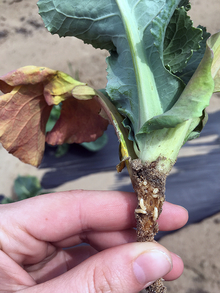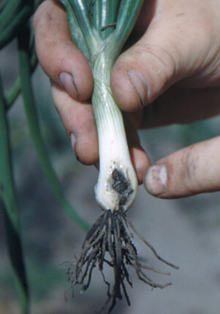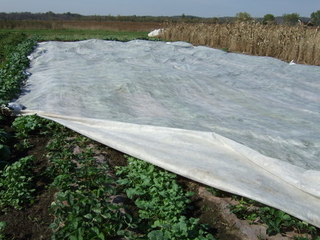Quick facts
- Two important root maggot species found in Minnesota are onion maggots (Delia antiqua) and cabbage maggots (D. radicum).
- Root maggots can occur in any year but are more common during cool, wet springs.
- Infested plants can appear discolored, wilted or stunted.
- Damage can be severe enough to kill affected vegetables.
- Physical barriers, like row covers, are the best way to manage them.
How to identify root maggots
Adults
- 1/4 inch long
- Dark gray with dark-colored stripes
- They resemble small house flies
Larvae
- Legless maggots
- 1/4 inch long
- Yellowish-white
- Shaped like cylinders, tapering towards the head
Plants attacked by root maggots
Onion maggots attack
- Onion
- Garlic
- Carrot
- Radish
Cabbage maggots attack
- Cabbage
- Broccoli
- Cauliflower
- Brussels sprouts
- Radishes
- Turnips
Biology
- Root maggots spend the winter as pupae in the soil.
- In spring, the maggots transform into adult flies.
- Adult females lay about 50-200 small, white eggs at the base of plant stems and in nearby cracks in the soil.
- The eggs hatch within a week into small, legless, whitish maggots.
- Maggots move into the soil and feed on the roots, root hairs and germinating seeds of crucifers or onions.
- After feeding for three to four weeks, maggots convert into pupae in plant roots or the surrounding soil.
- There are several generations per year.
Damage caused by root maggots
- Root maggots have several generations in a year, but most of their damage is limited to early spring plantings.
- Seedlings and transplants suffer more damage from root maggots during a wet, cold spring.
- The maggots feed on roots and bulbs, creating tunnels.
- Plants first begin to wilt and can become stunted and yellowed.
- Heavily damaged plants can ultimately die.
Managing root maggots in home gardens
Once you notice damage from root maggots it's too late to treat them. Protect your vegetables by preventing or removing conditions that favor root maggots.
If you regularly have experienced root maggot problems then you probably will see them again.
Keep your garden clean
- Do not use animal manure or green manure in your garden in spring. Rotting and decaying organic matter attracts root maggots and can lead to plant damage.
- When possible, wait until June 1st to plant varieties that can be attacked by root maggots.
- Remove target plants in the fall, including their roots, and destroy them. This will kill any pupae that might be left.
Exclude pests
Row covers are an effective option to prevent adult flies from getting near the plants to lay eggs.
- Choose a barrier that allows both sunlight and rain to get to the plants.
- Make sure to set up the barrier in your garden by the time adult flies are laying eggs, usually early to mid-May.
- Keep the barrier in place until the end of the month when the flies are finished laying eggs.
- Floating row covers may not be practical in large gardens.
- Row covers can be purchased at lawn and garden supply stores and online.
Do not place row covers if onions or other root vegetables were planted in the same area the previous year. Root maggots live through the winter as pupae in the soil near their target plants. Placing a row cover will trap adults that hatch from the pupae and it will no longer protect the plants from the flies. Practice crop rotation to minimize this issue: plant susceptible crops in different areas of your garden or alternate seasons when you grow them.
There are no insecticides available as a pre-plant treatment for cabbage and onion maggots in the home garden.
Managing root maggot on farms
Cultural controls
If possible, plant this year’s onion fields more than a half-mile away from last year’s onion planting. Planting later into the onion planting window will help them avoid the flight period for the first round of egg-laying onion maggot adults (though this must be balanced with bulb size considerations).
Floating row covers can exclude flies seeking egg-laying sites, as long as onions aren’t being planted in the same spot as the previous year.
To reduce overall populations, do not leave cull onions in the field, instead destroy, bury, or incorporate onions deeper into cull or compost piles (as flies will only have access to the outermost layer).
Chemical controls
There are no rescue treatments available once maggots are already feeding on onions, therefore all controls are preventative.
- It is not feasible to spray adults on leaves, as they are mobile and don’t spend a lot of time in onion fields outside of egg-laying.
- There are effective seed treatments available, as well as at-plant options.
For more information on chemical control, see the Midwest Vegetable Production Guide. Check product status before each season, as there is a lot of uncertainty around the future of some of the labeled products.
Monitoring
Cabbage maggot adults look like house flies and can be difficult to monitor. However, growers can use degree days to estimate peak emergence by accumulating degree-days after the ground has thawed. The daily formula to use is:
- Average temp (Maximum temperature + Minimum ambient temperature/2) - 43 degrees F.
- Peak emergence of the first three generations will occur when 300, 1475, and 2650 degree-days have accumulated, respectively.
- Automated degree-day maps for cabbage maggot in Minnesota are available and updated twice per week during the growing season.
Less formally, cabbage maggot adults emerge when yellow rocket weeds bloom, so that can be a clue that it is time to start using a physical barrier.
Cultural controls
Cover crop decisions can impact cabbage maggot. Brassica cover crops can provide places for cabbage maggots to build their populations.
Adult flies are attracted to freshly plowed fields and decaying organic matter. This means they are attracted to fields with recently terminated cover crops and green manures, as well as recently applied animal manures.
Time the termination and incorporation of these materials at least 3-4 weeks before planting when possible.
As long as cole crops aren’t being planted in the same spot as last year’s brassicas (be it crops or cover crops), exclusion netting is very effective for cabbage maggot control. Make sure to have row covers in place before cabbage maggots start to fly.
Chemical controls
Chemical controls for cabbage maggots are limited, and preventative in nature. There are no insecticides available for when plants are already being fed upon by maggots.
Products available include soil and tray drenches. For more information on chemical control, see the Midwest Vegetable Production Guide.
CAUTION: Mention of a pesticide or use of a pesticide label is for educational purposes only. Always follow the pesticide label directions attached to the pesticide container you are using. Be sure that the plant you wish to treat is listed on the label of the pesticide you intend to use. And observe the number of days between pesticide application and when you can harvest your crop. Remember, the label is the law.
Reviewed in 2022






